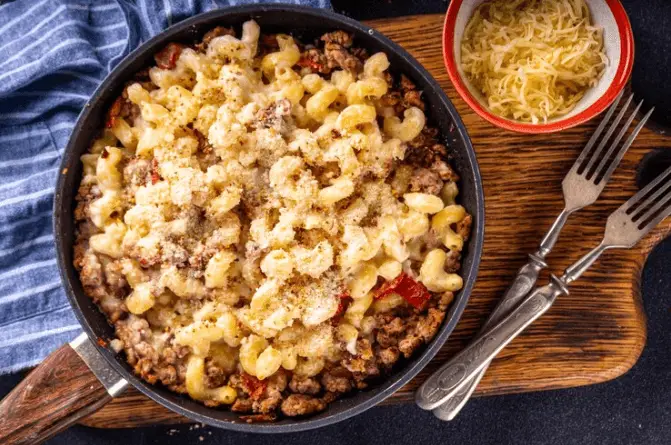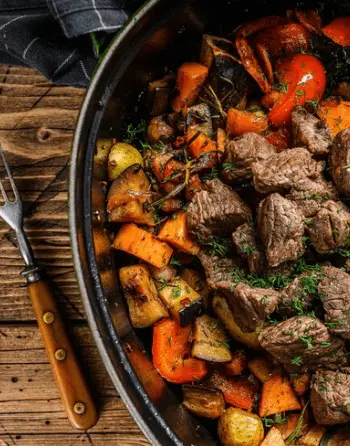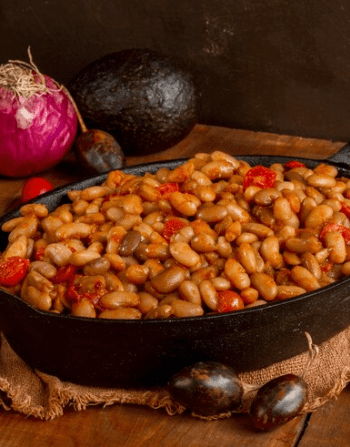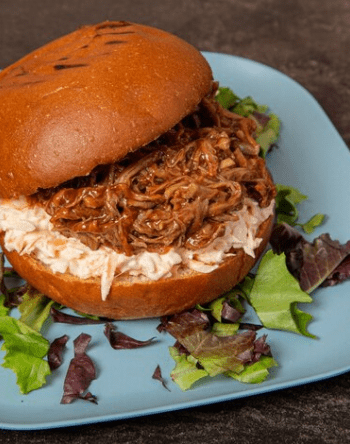I. Introduction
Hamburger Helper Recipe has been a staple in American households for decades, offering a quick and convenient meal solution for busy families. Its appeal lies in its simplicity—combining pasta, seasoning, and ground beef to create a hearty, satisfying dish. However, crafting a homemade version elevates this classic comfort food by introducing healthier ingredients, customizable flavors, and the flexibility to accommodate various dietary preferences.
This comprehensive guide will take you through the fascinating history of Hamburger Helper, highlight the benefits of making it from scratch, and provide you with a step-by-step recipe that’s both easy and delicious. Whether you’re new to cooking or a seasoned home chef, this guide will help you create a meal that everyone at the table will enjoy.
For more meal inspiration, don’t miss our Chicken & Broccoli Recipe—a perfect pairing for a wholesome dinner.
A. Overview of Hamburger Helper Recipe
Hamburger Helper is a packaged food product that includes dry pasta and a seasoning mix, designed to be combined with ground beef to create a complete meal. It was first introduced by General Mills in the 1970s as a response to rising meat prices and the need for economical meal solutions. Its ease of preparation, affordability, and versatility quickly made it a popular choice for American households.
Over the years, Hamburger Helper has expanded to include a variety of flavors, ranging from Cheeseburger Macaroni to Beef Stroganoff and even options for chicken and tuna. Its iconic mascot, the “Helping Hand,” became a symbol of convenience and comfort for generations of families.
B. Purpose of the Article
The goal of this article is to provide readers with a detailed and practical guide to creating a homemade version of Hamburger Helper. While the boxed version offers convenience, preparing it from scratch ensures that you can:
- Use fresh, wholesome ingredients for a healthier dish.
- Customize the flavors to suit your preferences.
- Adjust the recipe to accommodate dietary restrictions, such as gluten-free, dairy-free, or vegetarian options.
By the end of this guide, you’ll have all the tools and knowledge to make a delicious, homemade Hamburger Helper recipe that your family will love—without relying on boxed mixes.
II. History and Popularity of Hamburger Helper Recipe
A. Origin of Hamburger Helper Recipe
In response to meat shortages and economic challenges in the early 1970s, General Mills introduced Hamburger Helper as a way to extend ground beef and create a hearty meal. Its convenience and simplicity quickly made it a household favorite.
B. Evolution Over the Years
Over time, the product line expanded to include various flavors and meal options, such as Cheeseburger Macaroni, Beef Stroganoff, and even chicken and tuna variations. Marketing strategies and packaging have also evolved to meet changing consumer preferences.
C. Cultural Impact
Hamburger Helper has become ingrained in American culture, often associated with quick, family-friendly dinners. Its recognizable glove mascot and catchy jingles have contributed to its lasting presence in popular culture.
III. Benefits of Making Hamburger Helper Recipe from Scratch
A. Healthier Ingredients
One of the biggest advantages of making Hamburger Helper from scratch is the ability to control the quality and quantity of ingredients. Store-bought versions often contain high levels of sodium, preservatives, and artificial flavors, which can be less than ideal for those seeking a healthier lifestyle. By preparing it at home, you can:
- Reduce Sodium Levels: Use low-sodium broth and seasonings to maintain flavor without the excessive salt.
- Avoid Preservatives: Rely on fresh, natural ingredients instead of boxed additives.
- Increase Nutritional Value: Add vegetables like spinach, bell peppers, or mushrooms to boost the dish’s vitamin and mineral content.
- Use Organic Options: Choose organic beef, pasta, or dairy products to enhance the dish’s overall quality.
Homemade Hamburger Helper recipe is a better choice for individuals who prioritize clean eating and want a nutritious meal without sacrificing taste.
B. Customizable Flavors: Hamburger Helper Recipe
One of the joys of making Hamburger Helper from scratch is the freedom to adjust the recipe to suit your preferences. Whether you’re a fan of bold, spicy dishes or prefer something more mild and comforting, the options are endless:
- Spicier Kick: Add chili flakes, cayenne pepper, or jalapeños for heat.
- Milder Options: Use a blend of garlic powder, onion powder, and paprika for a classic flavor.
- Cheese Variety: Experiment with cheddar, mozzarella, Monterey Jack, or even a blend of cheeses to create unique flavor profiles.
- Regional Twists: Incorporate Italian seasoning for a Mediterranean vibe or taco spices for a Tex-Mex flair.
This level of customization ensures your dish caters to your family’s tastes while adding variety to your weekly meals.
C. Dietary Accommodations
Homemade Hamburger Helper allows for seamless adjustments to meet various dietary needs, making it a versatile option for everyone at the table:
- Gluten-Free: Substitute traditional pasta with gluten-free alternatives made from rice, chickpeas, or lentils. Ensure any broth or seasonings used are also gluten-free.
- Low-Carb or Keto-Friendly: Swap the pasta for zucchini noodles, cauliflower rice, or shirataki noodles to reduce carbohydrate content.
- Vegetarian or Vegan Options: Replace ground beef with plant-based crumbles or lentils, and use non-dairy milk and vegan cheese for a fully vegan version.
- Dairy-Free: Opt for almond, oat, or coconut milk and dairy-free cheese alternatives to suit lactose-intolerant diners.
Tailoring the recipe to specific dietary restrictions ensures that everyone can enjoy a hearty, satisfying meal without compromise.

IV. Essential Ingredients for Homemade Hamburger Helper Recipe
A. Protein Options
- Ground Beef: The traditional choice for a classic flavor.
- Ground Turkey or Chicken: Leaner alternatives for a lighter dish.
- Plant-Based Proteins: Suitable for vegetarian or vegan versions.
B. Pasta Selections
- Elbow Macaroni: Commonly used for its size and texture.
- Shells or Rotini: Options that hold sauce well.
- Gluten-Free Pasta: For those with gluten sensitivities.
C. Sauce Components: Hamburger Helper Recipe
- Broth: Beef or vegetable broth as the base for depth of flavor.
- Dairy: Milk or cream for creaminess; non-dairy alternatives for lactose intolerance.
- Cheese: Cheddar for sharpness; options for other cheese varieties.
D. Seasonings and Spices
- Paprika: Adds a mild, smoky flavor.
- Garlic and Onion Powder: Essential for savory depth.
- Mustard Powder: Provides a tangy undertone.
- Salt and Pepper: To taste, enhancing overall flavor.
Check out AllRecipes for additional flavor inspirations.
V. Step-by-Step Recipe for Homemade Hamburger Helper Recipe
A. Preparation
- Gather Ingredients: Ensure all ingredients are measured and ready.
- Equipment: Have a large skillet or pot, stirring utensils, and measuring cups/spoons on hand.
B. Cooking Instructions
- Sautéing the Protein
- Heat a large skillet over medium heat.
- Add chosen protein and cook until browned; drain excess fat if necessary.
- Adding Aromatics
- Incorporate diced onions and minced garlic; sauté until translucent.
- Incorporating Liquids and Pasta
- Pour in broth and milk, stirring to combine.
- Add pasta and bring the mixture to a boil.
- Reduce heat, cover, and let simmer until pasta is al dente.
- Seasoning the Dish
- Sprinkle in spices: paprika, garlic powder, onion powder, mustard powder, salt, and pepper.
- Stir thoroughly to ensure even distribution.
- Finalizing with Cheese
- Once pasta is cooked, reduce heat to low.
- Stir in shredded cheese until melted and the sauce is creamy.
C. Serving Suggestions
- Garnish with freshly chopped parsley or chives for color and freshness.
- Serve hot, accompanied by a side salad or steamed vegetables.
VI. Variations and Additions
A. Vegetable Enhancements
- Bell Peppers: Add for sweetness and color.
- Mushrooms: Introduce for an earthy flavor.
- Spinach or Kale: Incorporate for added nutrition.
B. Spice Modifications: Hamburger Helper Recipe
- Chili Flakes: For those who prefer a spicy kick.
- Italian Seasoning: To give a Mediterranean twist.
- Cumin and Coriander: For a subtle, warm flavor profile.
C. Alternative Cheeses
- Monterey Jack: For a milder, creamy texture.
- Pepper Jack: To add a hint of heat.
- Mozzarella: For a stretchy, gooey consistency.
Check out MyPlate for healthy ingredient substitutions.
VII. Tips for Perfecting Your Homemade Hamburger Helper Recipe
Crafting the perfect homemade Hamburger Helper is all about technique and attention to detail. Follow these tips to ensure a delicious, restaurant-quality dish every time:
- Consistent Stirring: Stir frequently while cooking to prevent the pasta from sticking to the bottom of the pan and to ensure even distribution of the sauce and seasonings.
- Proper Simmering: Once the liquid begins to boil, reduce the heat to a gentle simmer. This allows the pasta to cook thoroughly without becoming overcooked or mushy.
- Taste Testing: Periodically taste the dish as it cooks to ensure the flavors are balanced. Adjust seasonings like salt, pepper, or spices to suit your taste preferences.
- Cheese Addition: Always add shredded cheese off the heat. Stirring it in while the pan is still on the burner can cause the cheese to separate and become grainy.
With these tips, your homemade Hamburger Helper will turn out creamy, flavorful, and perfectly cooked every time.

VIII. Common Mistakes to Avoid
Avoid these common pitfalls to ensure a successful Hamburger Helper recipe:
- Overcooking Pasta: Pasta that cooks for too long becomes mushy and unappetizing. Keep a close eye on it and check for doneness frequently.
- Insufficient Seasoning: Bland dishes are a result of not using enough seasoning. Don’t hesitate to season generously with your favorite spices and herbs.
- High Heat Cooking: Cooking on high heat can lead to burning or uneven cooking. Maintain medium to low heat for better control and results.
By steering clear of these mistakes, you’ll achieve a dish that’s as tasty as it is satisfying.
IX. Storing and Reheating Leftovers
Homemade Hamburger Helper is just as delicious the next day when stored and reheated correctly.
A. Storage
- Transfer any leftovers to an airtight container to maintain freshness.
- Refrigerate the dish for up to 3 days to enjoy it later.
B. Reheating
- On the Stovetop: Reheat over low heat, adding a splash of milk or broth to restore the creaminess of the sauce. Stir frequently to ensure even heating.
- In the Microwave: Heat in short intervals, pausing to stir between each session. This prevents uneven heating and keeps the pasta moist.
Proper storage and reheating techniques ensure your leftovers retain their flavor and texture.
X. Nutritional Information: Hamburger Helper Recipe
Homemade Hamburger Helper is not only delicious but also offers a well-rounded nutritional profile. Here’s an approximate breakdown per serving:
- Calories: Around 400, depending on portion size and ingredients.
- Protein: Typically 20–25 grams, depending on the protein choice (e.g., ground beef, turkey, or plant-based crumbles).
- Carbohydrates: Approximately 50 grams, varying with the type of pasta used.
- Fats: Around 15 grams, influenced by cheese, dairy, and meat selections.
Note: Nutritional values may vary based on ingredient substitutions and portion sizes. Adjust accordingly for specific dietary needs.
XI. Frequently Asked Questions (FAQs)
How Long is Cooked Hamburger Helper Good For?
Cooked Hamburger Helper can be safely stored in the refrigerator for 3 to 4 days when kept in an airtight container. To maintain its flavor and texture, reheat only the portion you plan to eat and use the stovetop or microwave for even heating. If you want to store it longer, consider freezing it for up to 3 months. Always check for signs of spoilage, like off smells or changes in texture, before consuming leftovers.
What Happens if You Don’t Use Milk in Hamburger Helper?
If you don’t use milk in Hamburger Helper, the dish may lose some of its creaminess and rich flavor. However, you can substitute milk with alternatives like unsweetened almond milk, oat milk, coconut milk, or even plain yogurt for a similar texture. If you’re out of milk entirely, adding extra broth or water with a touch of butter can help achieve a creamy consistency, though the flavor may be slightly different.
Can You Eat Hamburger Helper After the Expiration Date?
While it’s generally not recommended to eat Hamburger Helper after its expiration date, the dry mix components may still be safe to consume if stored properly in a cool, dry place. Always inspect the package for signs of spoilage, such as unusual clumps, discoloration, or a rancid smell. For the best taste and safety, it’s ideal to use it before the printed date.
For more inspiration Check our Chicken & Broccoli Recipe
What Does Hamburger Helper Require?
To prepare a boxed Hamburger Helper recipe, you’ll typically need these basic ingredients:
- Ground beef (or a protein alternative like turkey or plant-based crumbles).
- Milk, for creaminess.
- Water or broth, for cooking the pasta and creating the sauce.
Homemade Hamburger Helper requires similar components but allows for more flexibility with seasonings, cheese varieties, and fresh vegetables to customize the dish to
XII. Internal Linking Opportunities
To enhance the Hamburger Helper recipe experience, explore related recipes and techniques:
- For a comforting twist, check out our Creamy One-Pot Pasta Recipe.
- Pair your Hamburger Helper with a side like our Easy Garlic Bread Recipe.
- Learn tips for meal prep with our Quick and Easy Dinner Ideas guide.

Conclusion
Homemade Hamburger Helper is a perfect combination of nostalgia, convenience, and health-conscious cooking. By following this guide, you can recreate this classic dish with fresh, wholesome ingredients while tailoring it to your family’s tastes. Whether you prefer the traditional flavors or want to experiment with new variations, making Hamburger Helper from scratch is an easy and rewarding experience.
Start cooking today and enjoy the satisfaction of serving a meal that’s as delicious as it is customizable!





